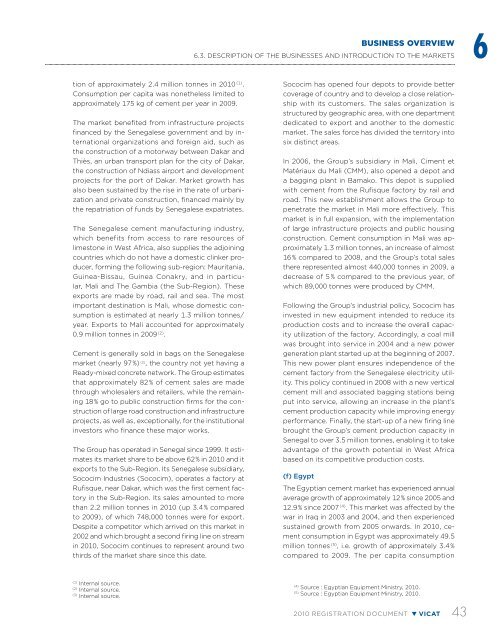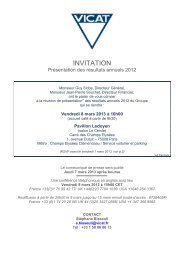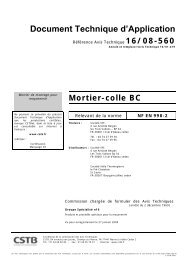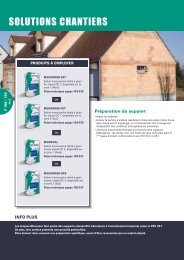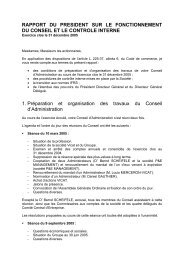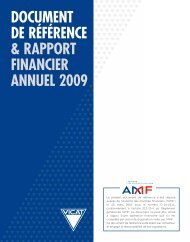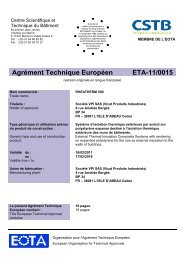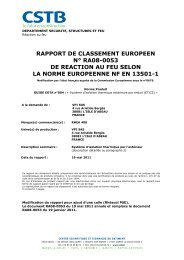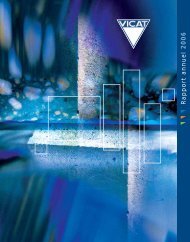6 - Vicat
6 - Vicat
6 - Vicat
Create successful ePaper yourself
Turn your PDF publications into a flip-book with our unique Google optimized e-Paper software.
6BUSINESS OVERVIEW6.3. Description of the businesses and introduction to the marketstion of approximately 2.4 million tonnes in 2010 (1) .Consumption per capita was nonetheless limited toapproximately 175 kg of cement per year in 2009.The market benefited from infrastructure projectsfinanced by the Senegalese government and by internationalorganizations and foreign aid, such asthe construction of a motorway between Dakar andThiès, an urban transport plan for the city of Dakar,the construction of Ndiass airport and developmentprojects for the port of Dakar. Market growth hasalso been sustained by the rise in the rate of urbanizationand private construction, financed mainly bythe repatriation of funds by Senegalese expatriates.The Senegalese cement manufacturing industry,which benefits from access to rare resources oflimestone in West Africa, also supplies the adjoiningcountries which do not have a domestic clinker producer,forming the following sub-region: Mauritania,Guinea-Bissau, Guinea Conakry, and in particular,Mali and The Gambia (the Sub-Region). Theseexports are made by road, rail and sea. The mostimportant destination is Mali, whose domestic consumptionis estimated at nearly 1.3 million tonnes/year. Exports to Mali accounted for approximately0.9 million tonnes in 2009 (2) .Cement is generally sold in bags on the Senegalesemarket (nearly 97 %) (3) , the country not yet having aReady-mixed concrete network. The Group estimatesthat approximately 82 % of cement sales are madethrough wholesalers and retailers, while the remaining18 % go to public construction firms for the constructionof large road construction and infrastructureprojects, as well as, exceptionally, for the institutionalinvestors who finance these major works.The Group has operated in Senegal since 1999. It estimatesits market share to be above 62 % in 2010 and itexports to the Sub-Region. Its Senegalese subsidiary,Sococim Industries (Sococim), operates a factory atRufisque, near Dakar, which was the first cement factoryin the Sub-Region. Its sales amounted to morethan 2.2 million tonnes in 2010 (up 3.4 % comparedto 2009), of which 748,000 tonnes were for export.Despite a competitor which arrived on this market in2002 and which brought a second firing line on streamin 2010, Sococim continues to represent around twothirds of the market share since this date.Sococim has opened four depots to provide bettercoverage of country and to develop a close relationshipwith its customers. The sales organization isstructured by geographic area, with one departmentdedicated to export and another to the domesticmarket. The sales force has divided the territory intosix distinct areas.In 2006, the Group’s subsidiary in Mali, Ciment etMatériaux du Mali (CMM), also opened a depot anda bagging plant in Bamako. This depot is suppliedwith cement from the Rufisque factory by rail androad. This new establishment allows the Group topenetrate the market in Mali more effectively. Thismarket is in full expansion, with the implementationof large infrastructure projects and public housingconstruction. Cement consumption in Mali was approximately1.3 million tonnes, an increase of almost16 % compared to 2008, and the Group’s total salesthere represented almost 440,000 tonnes in 2009, adecrease of 5 % compared to the previous year, ofwhich 89,000 tonnes were produced by CMM.Following the Group’s industrial policy, Sococim hasinvested in new equipment intended to reduce itsproduction costs and to increase the overall capacityutilization of the factory. Accordingly, a coal millwas brought into service in 2004 and a new powergeneration plant started up at the beginning of 2007.This new power plant ensures independence of thecement factory from the Senegalese electricity utility.This policy continued in 2008 with a new verticalcement mill and associated bagging stations beingput into service, allowing an increase in the plant’scement production capacity while improving energyperformance. Finally, the start-up of a new firing linebrought the Group’s cement production capacity inSenegal to over 3.5 million tonnes, enabling it to takeadvantage of the growth potential in West Africabased on its competitive production costs.(f) EgyptThe Egyptian cement market has experienced annualaverage growth of approximately 12 % since 2005 and12.9 % since 2007 (4) . This market was affected by thewar in Iraq in 2003 and 2004, and then experiencedsustained growth from 2005 onwards. In 2010, cementconsumption in Egypt was approximately 49.5million tonnes (5) , i.e. growth of approximately 3.4 %compared to 2009. The per capita consumption(1)Internal source.(2)Internal source.(3)Internal source.(4)Source : Egyptian Equipment Ministry, 2010.(5)Source : Egyptian Equipment Ministry, 2010.2010 registration document VICAT 43


